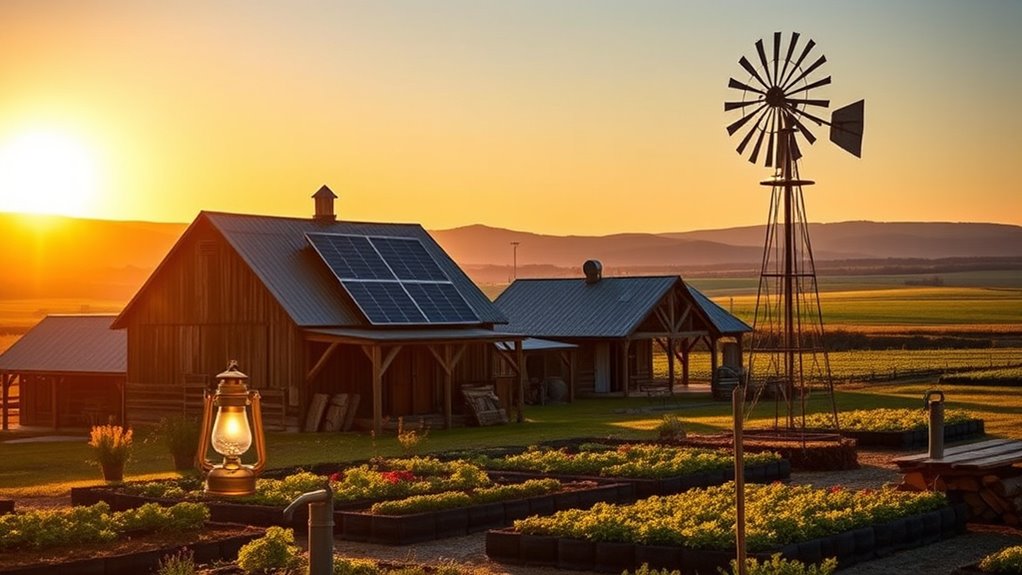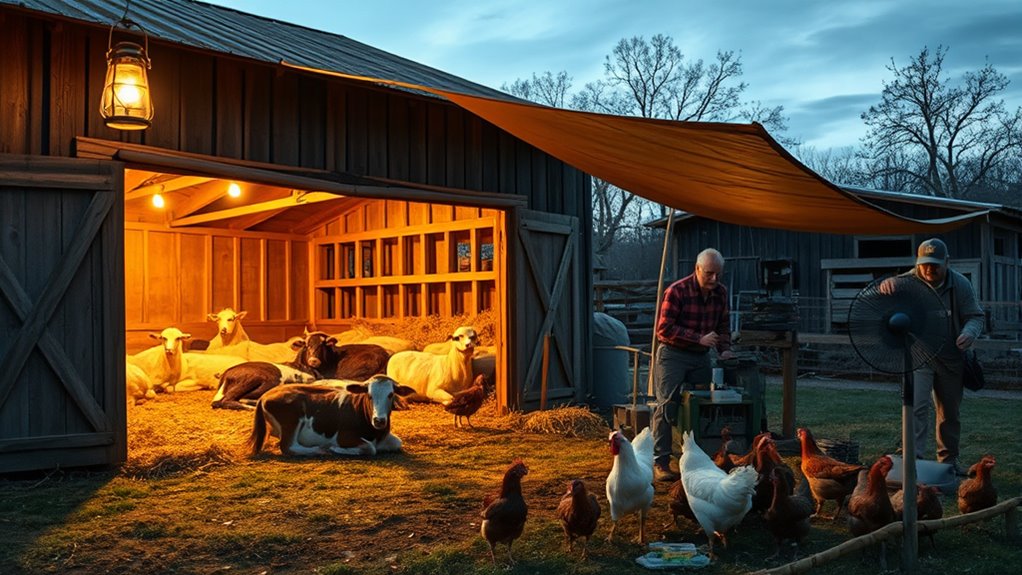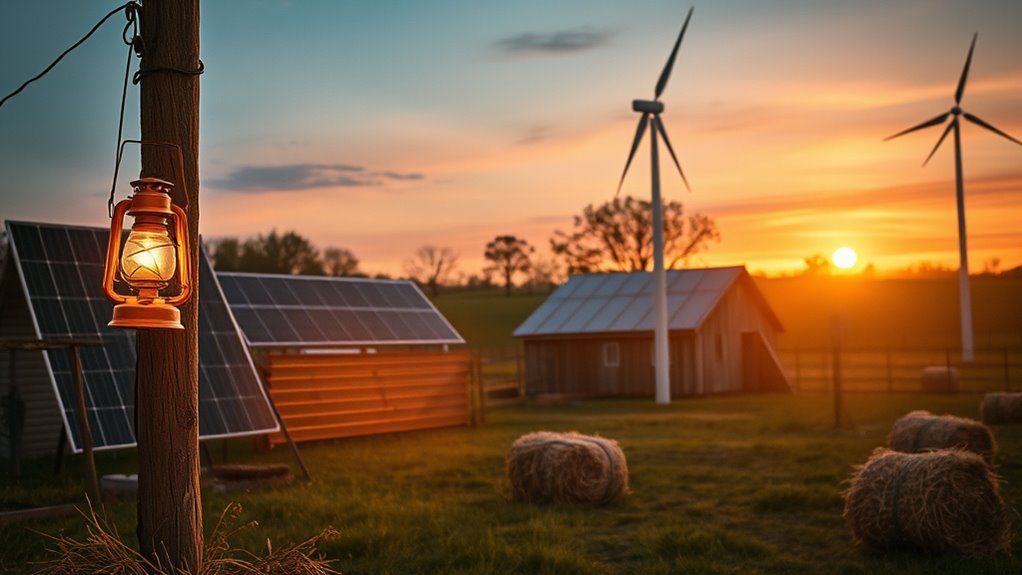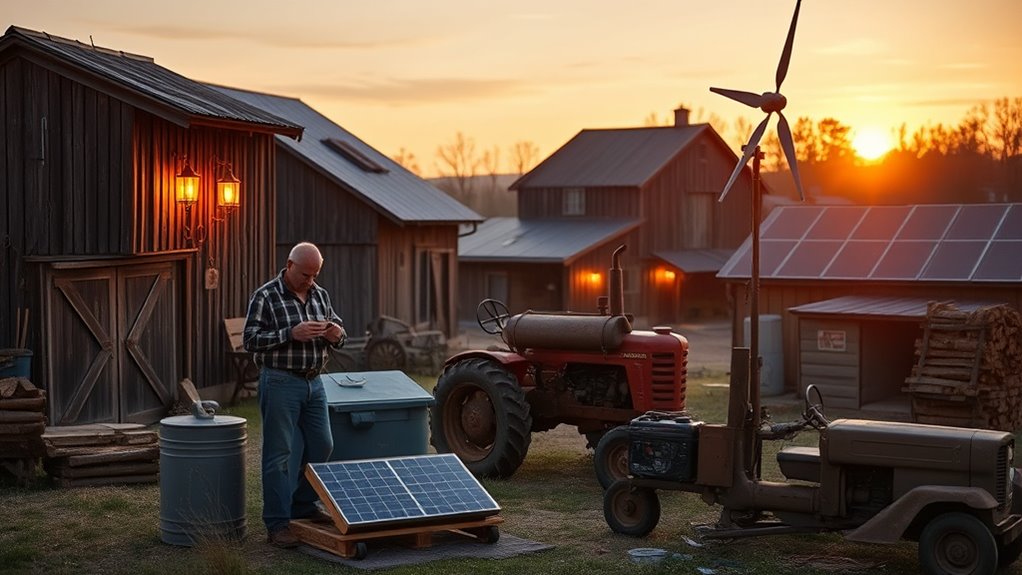To survive extended power outages on your farm, you should prepare backup systems like reliable generators, solar panels, and wind turbines. Keep animal shelters secure and supply enough water and food to prevent shortages. Maintain communication with batteries and radios, inspect your equipment carefully once power returns, and prioritize safety. Efficient recovery depends on proper planning, storage, and damage assessments. Stay ahead of outages by exploring these strategies, and you’ll learn how to keep your farm resilient.
Key Takeaways
- Invest in reliable backup power sources like generators, solar panels with batteries, and wind turbines to maintain critical farm operations.
- Conduct thorough damage inspections of equipment and infrastructure before restoring power to ensure safety and functionality.
- Provide shelter, emergency water, and monitor animal health to safeguard livestock during extended outages.
- Maintain communication with emergency contacts, keep safety supplies ready, and monitor food and water stores regularly.
- Develop and regularly update a farm recovery plan, including supply management and safety protocols, for swift restoration after outages.
Preparing Your Farm Before an Outage

To minimize the impact of a power outage on your farm, you need to prepare in advance. Start by evaluating your energy needs and identifying critical systems that require backup power. Invest in reliable generators and ensure they’re properly maintained and fueled. Stock up on essential supplies, like batteries, fuel, and portable lighting, to keep operations running smoothly. Develop a detailed emergency plan that includes contact information for local utilities and emergency services. Train your staff on how to respond during outages and conduct regular drills. Additionally, consider installing surge protectors and backup power sources for sensitive equipment. Exploring Uninterruptible Power Supplies (UPS) options can provide immediate backup power for crucial electronics. Being proactive ensures you’re ready to act quickly, reducing downtime and safeguarding your farm’s productivity when the power goes out.
Ensuring Animal Welfare During Power Loss

During a power outage, you need to guarantee your animals stay safe and comfortable. Make sure they have adequate shelter to protect them from the elements, and provide emergency water to keep them hydrated. Keep a close eye on their health and behavior to catch any issues early. Additionally, monitoring their environment closely can help prevent stress caused by sudden changes, which is especially important during power outages.
Maintain Adequate Shelter
When the power goes out, maintaining adequate shelter becomes essential to guarantee your animals stay safe and comfortable. Check that all structures are secure, with no gaps or loose panels that could expose them to harsh weather. Insulate shelters as much as possible using straw, hay, or blankets to retain warmth during cold nights. Elevate bedding to prevent dampness and rot, and add extra bedding if needed. Close vents or windows to block wind and drafts, ensuring a stable temperature inside. Keep shelters clean and dry to prevent illness. If weather conditions worsen, consider additional coverings or temporary structures to shield animals from rain, snow, or wind. Regularly inspecting and maintaining your shelter can also enhance the effectiveness of your protective measures. Prioritizing shelter helps reduce stress and keeps your animals healthy during prolonged power outages.
Provide Emergency Water
Have you prepared enough emergency water supplies for your animals? Ensuring they stay hydrated during a power outage is essential. Here are three key steps:
- Stockpile enough clean water—aim for at least three days’ worth per animal.
- Use large, food-grade containers that are easy to refill and transport.
- Keep water sources shaded and covered to prevent contamination and algae growth.
- Consider the importance of water quality and regularly test stored water to ensure it remains safe for your animals.
Regularly check and rotate your stored water to keep it fresh. Consider installing manual or gravity-fed watering systems that don’t rely on electricity. If possible, set up rainwater collection to supplement your supplies. Proper planning now prevents dehydration and stress for your animals later. Being prepared with emergency water supplies can make a significant difference in their health and well-being during extended outages.
Monitor Animal Health
Maintaining vigilant observation of your animals’ health is essential when power outages disrupt normal care routines. Regularly check for signs of distress, dehydration, or illness, especially if feeding or watering schedules are altered. Watch for abnormal behavior, lethargy, or labored breathing, which can indicate underlying problems. Keep a close eye on temperature-sensitive animals, like poultry or newborns, as they are more vulnerable to temperature swings. Maintain a detailed log of any health issues or changes you observe. If you notice symptoms of illness, isolate affected animals if possible and consult your veterinarian. Early detection and prompt response can prevent minor issues from becoming serious. Staying attentive ensures your animals remain healthy and resilient during extended power outages. Additionally, understanding resources and tools available can help you better manage animal welfare during emergencies.
Preserving Food and Water Supplies

During a power outage, safeguarding your farm’s food and water supplies becomes essential to prevent spoilage and ensure safety. Without electricity, refrigeration and water systems can quickly fail, risking contamination and waste. To protect your resources, consider these steps:
- Use coolers and ice packs to keep perishable foods cold if the power remains out for an extended period.
- Store water in airtight containers and fill bathtubs or large tanks with clean water for drinking and sanitation.
- Prioritize perishable items—consume or preserve them first, and consider canning or drying foods for longer storage.
- Regularly monitor and assess stored water and food supplies to ensure they remain safe and uncontaminated, especially during prolonged outages. proper storage practices can help maintain the quality and safety of your resources.
Act quickly to minimize spoilage, and always verify water quality before use. Proper preservation keeps your farm safe and food supplies intact during outages.
Maintaining Communication and Safety

When a power outage strikes your farm, staying connected and ensuring safety become top priorities. Keep your cell phone charged using portable power banks or car chargers, so you can call for help if needed. Maintain a list of emergency contacts and share your plans with family or neighbors. Use a battery-powered or hand-crank radio to stay informed about weather updates and emergency alerts. Establish clear safety protocols, like checking for gas leaks or fires, and ensure everyone knows how to respond. Keep flashlights, batteries, and first aid supplies accessible. Avoid unnecessary movements in unsafe conditions, and stay calm. Proper wall organization can help keep your space safe and clutter-free during emergencies. By maintaining communication and safety measures, you minimize risks and stay prepared to handle the situation effectively.
Alternative Power Sources and Backup Systems

To guarantee your farm stays operational during power outages, investing in alternative power sources and backup systems is essential. These solutions ensure your critical equipment keeps running and minimize downtime.
Consider these options:
- Solar Panels with Batteries – Harness sunlight during the day and store energy for nighttime use, providing a reliable, renewable power source.
- Generators – Use gas or propane-powered generators for immediate, high-capacity backup during outages. Keep fuel stocked and maintain the unit regularly.
- Wind Turbines – If your location is suitable, wind turbines can supplement power, especially during storms when other sources might falter.
Enhancing your understanding of fandom’s resilience can help you adapt your farm’s backup strategies to better withstand extended outages.
Diversifying your backup options enhances resilience, keeps your farm productive, and safeguards your livestock and crops.
Post-Outage Recovery and Assessment

Once the power is back, you need to carefully check your equipment and infrastructure for any damage. Then, assess your supplies to see what’s missing or spoiled and make plans to restock promptly. This process helps guarantee your farm recovers quickly and stays prepared for future outages. Considering the importance of maintaining your farm’s health, incorporating nutrient-rich ingredients into your recovery plan can support faster healing and resilience.
Damage Inspection Routine
After a power outage, conducting a thorough damage inspection is crucial to guarantee the safety and functionality of your farm. Start by checking all electrical systems to identify any exposed wiring, damaged outlets, or broken equipment that could pose hazards. Next, examine your livestock and crops for signs of stress or injury caused by the outage or temperature fluctuations. Finally, inspect your buildings, fences, and water systems for structural damage or leaks that might have occurred during the outage. Regular safety checklists can help ensure all critical areas are thoroughly reviewed. Completing this routine promptly helps prevent further issues and guarantees your farm remains safe and operational.
Restocking and Replenishment
When the power is restored, prioritize evaluating your farm’s inventory to determine what needs restocking. Check your refrigerated and frozen supplies first; discard anything spoiled or unsafe. Review your feed and seed stocks, noting shortages or damages caused by the outage. Replenish essential supplies like medications, cleaning products, and tools. Contact suppliers to order replacements for depleted items, and keep track of delivery times to plan future stockpiling. Assess your backup storage methods—such as coolers or generators—to ensure they’re still effective. Restocking isn’t just about replacing what’s gone; it’s an opportunity to improve inventory management. Document what was lost or damaged for future reference. This process helps you regain normal operations quickly and prepares you better for potential future outages.
Frequently Asked Questions
How Can I Prevent Disease Outbreaks During Prolonged Outages?
To prevent disease outbreaks during prolonged outages, you should keep your animals clean and dry, regularly disinfect their living areas, and monitor their health closely. Make certain proper ventilation and avoid overcrowding. Store feed in a dry, secure place to prevent contamination. Quarantine new or sick animals immediately, and maintain good hygiene practices. Staying vigilant and proactive helps reduce disease risks during power outages.
What Are Cost-Effective Ways to Upgrade My Farm’s Power Backup?
Think of upgrading your farm’s power backup like planting a sturdy tree—strong roots keep everything steady. You can start with solar panels and a battery system, which cut costs and harness the sun’s free energy. Consider portable generators for quick power boosts, and prioritize energy-efficient equipment to stretch your backup’s lifespan. These affordable steps will keep your farm humming smoothly, rain or shine, without breaking the bank.
How Do I Train Staff for Emergency Power Outage Protocols?
You should start by developing clear, written protocols for emergency power outages and hold regular training sessions with your staff. Use hands-on drills to simulate power loss scenarios, so everyone knows their roles. Encourage questions and provide quick reference guides. Keep training updated, especially when new equipment or procedures are introduced. Regular practice guarantees your team responds swiftly and confidently during actual outages, minimizing downtime and risk.
What Legal or Insurance Considerations Are Involved in Outage Scenarios?
You need to check your insurance policies to guarantee coverage for power outages, as they can be more unpredictable than a tornado. Legally, you must comply with safety regulations and report damages if required. Failure to follow proper procedures might void your coverage or lead to fines. Consult an attorney or insurance agent to clarify your policies, so you’re prepared for any scenario and avoid surprises that could wipe out your farm’s finances.
How Can I Efficiently Reuse or Recycle Resources During Extended Outages?
You can efficiently reuse or recycle resources during extended outages by repurposing containers for water storage, composting organic waste, and salvaging materials like wood and metal for repairs. Use greywater for irrigation where safe, and encourage crop and livestock practices that minimize waste. Additionally, consider creating a barter system with neighbors to exchange surplus supplies, reducing reliance on external resources and maximizing what you already have on hand.
Conclusion
When the power finally flickers back on, it’s like emerging from a long winter’s night into the dawn. Your preparations and quick actions are the steady hand guiding you through the storm’s aftermath. With resilience and careful assessment, you’ll restore your farm’s heartbeat, turning chaos into calm. Remember, every challenge faced is a seed of strength, blooming into a resilient farm that stands tall, weathering any storm the future holds.










